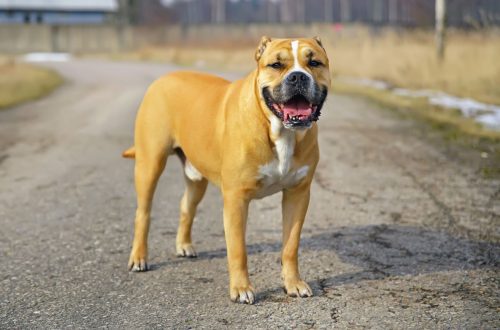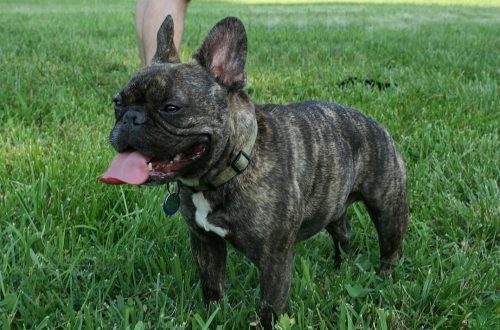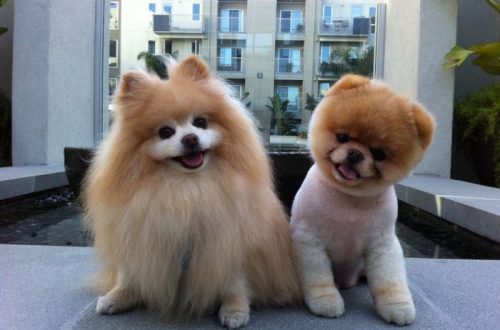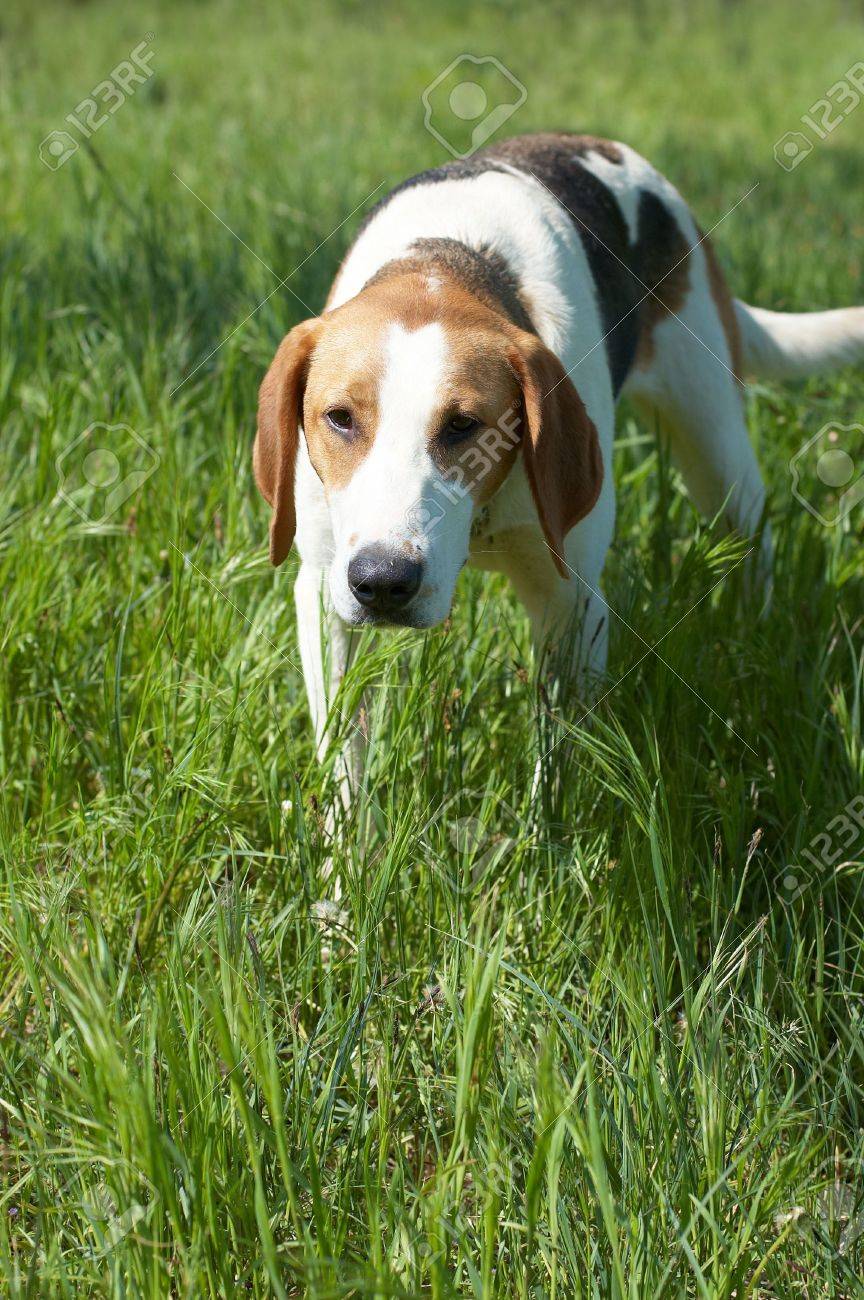
Russian Piebald Hound
Other names: RPG , Anglo-Russian hound
The Russian Spotted Hound is a versatile hunting dog, masterfully working both on a fox and a hare, and on a wolf. The breed was bred by domestic breeders by crossing the Russian hound with English and French representatives of the group.
Contents
- Characteristics of Russian Piebald Hound
- Basic moments
- The history of the breed Russian piebald hound
- Video: Russian piebald hound
- The appearance of the Russian piebald hound and its differences from the Russian hound
- The nature of the Russian piebald hound
- Education and training
- Hunting with a Russian piebald hound
- Maintenance and care
- Health and disease of Russian piebald hounds
- How to choose a puppy of Russian Piebald Hound
- The price of the Russian piebald hound
Characteristics of Russian Piebald Hound
| Country of origin | Russia |
| The size | Average |
| Growth | males 58-68 cm, females 58-64 cm |
| Weight | 25-35 kg |
| Age | 12-16 years |
| FCI breed group | Hounds |
Basic moments
- Russian piebald hounds are quite talkative, but they do not always use their voice for their intended purpose, so you will have to get used to the pet’s periodic idle talk.
- The breed is not recognized by the FCI and is not widely represented abroad.
- If we do not take into account the individual characteristics of each dog, then in general, RPGs are more viscous and vicious towards the beast than their relatives – Russian hounds .
- This is not the most controllable breed, especially out of hunting, so taking a hound puppy in order to mold him into a companion or an obedient city dweller is a pointless exercise.
- The Russian piebald hound is not a pet for an apartment, especially if small animals like cats, chinchillas and other objects of dog interest live in it.
- Despite the generally non-conflict nature, the desire for leadership and independence is not alien to the representatives of the breed. For this reason, dogs are not recommended for purchase by inexperienced owners who have a vague idea of the principles of training and training hounds.
- Adults have phenomenal endurance, so intense physical activity is only good for them. In addition, instead of the standard two-time walking, the Anglo-Russian hounds are entitled to three hourly promenades daily.
- Following the trail left by the beast, the dogs “turn off” their hearing and do not respond to the call for a long time. On the one hand, such behavior is considered a guarantee of the fascination and profitability of hunting, and on the other hand, the main reason that animals get lost in the forest and cannot get out of the thicket on their own.
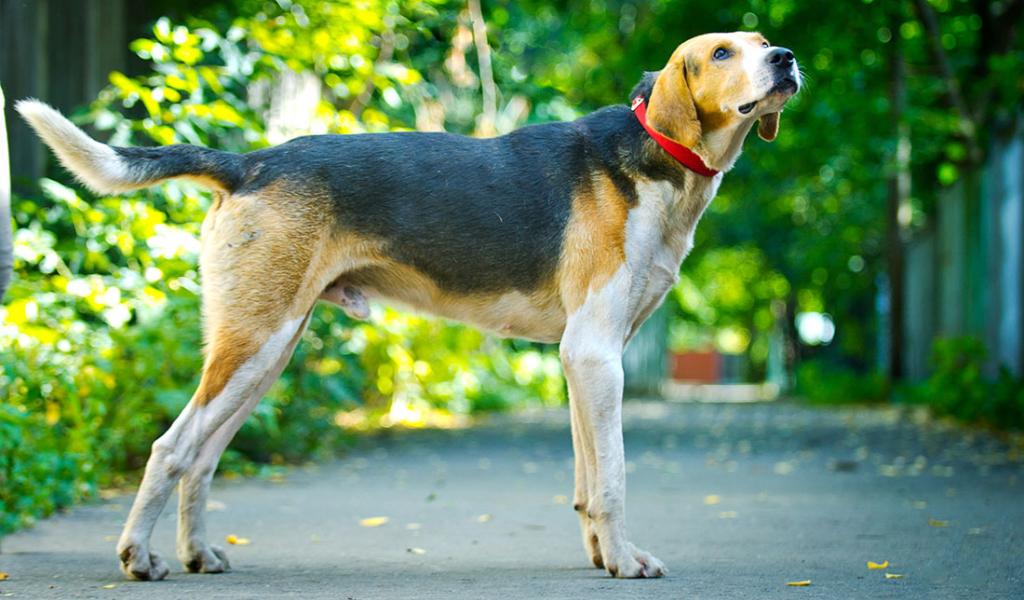
The Russian piebald hound is an ambitious and reckless fan of gun hunting, able to turn a field trip into an exciting quest. With a stable psyche and a relatively calm temperament, this persistent clever girl quickly finds contact with the owner, provided that he is not too lazy to set aside time for daily jogging and excursions in her company. However, do not flatter yourself too much about the feelings of a dog for a person. Work for the Russian piebald hound has always been and will remain in the first place. Accordingly, one can earn the love of an animal only by being imbued with the hunting craft to the extent that the dog itself is imbued with it.
The history of the breed Russian piebald hound
In Russia at the beginning of the 19th century, all and sundry were engaged in breeding hounds, which ultimately led to the loss of a single breed type by animals. Each landowner, able to maintain a kennel, considered it his direct duty to play a breeder. As a result: the blood of the harlequins, as well as the Polish and busty hounds spontaneously rushed to the dogs, which affected not only the appearance, but also the working qualities of the offspring. In particular, by the middle of the 19th century, Russian hounds lost their natural viciousness and became unsuitable for hunting wolves.
They decided to correct the situation by crossing the domestic livestock with foxhounds. The latter at that time were considered reference hunters and already had a stable phenotype, which the Russian hounds lacked so much . As a result of the mating of the two breeds, elegant in terms of color and hardy dogs were born, which inherited aggressiveness towards the beast from the English parent, and outstanding rutting abilities and sonorous, melodic barking from the Russian.
At first, experiments on breeding a universal hunting dog were of an unsystematic nature and were not always successful. In addition, some of the owners, in addition to English hounds, used French manufacturers for mating. Nevertheless, by the 30s of the 19th century, a group of leaders emerged among the breeders, whose flocks were considered the most successful in conformation and working terms. In particular, individuals from the kennels of S. M. Glebov, P. A. Bereznikov and I. L. Kramarenko enjoyed increased popularity among professional hunters.
At the beginning of the 20th century, the descendants of foxhounds and Russian hounds began to be bred on purpose. By that time, the breed managed to declare itself at exhibitions and acquire its own name. Now its representatives were called Anglo-Russian hounds – in memory of British roots. Unfortunately, after the collapse of the Russian Empire, animals were on the verge of extinction. As an example: only eight individuals were exhibited at the 1923 exhibition, and even those were very different from each other in external indicators.
The Anglo-Russian hound received its first official standard at the All-Union Cynological Congress in 1925, which dramatically increased its value in the eyes of the townsfolk and amateur hunters. So, before the Great Patriotic War in the USSR, there were already about six elite lines of hounds, whose representatives became the ancestors of all today’s individuals. As for the change of the name of the breed from the Anglo-Russian to the Russian piebald hound, this procedure was carried out in 1947 (according to another version – in 1951).
Video: Russian piebald hound
The appearance of the Russian piebald hound and its differences from the Russian hound
Despite the close family relationship between the piebald hound and the Russian hound , the breeds are not complete copies of each other, although it can be difficult to establish the animal’s belonging to one or another clan on the go. Usually, the Russian Pinto Hound is identified by its bright spotted color with characteristic blush. In addition, representatives of this family are “dressed” poorer than their fellow tribesmen. There are small discrepancies between the breeds in the shape of the ear cloth, as well as in movements (the step of the Russian hound is noticeably lighter). At the same time, the growth of both the Russian hound and the piebald hound is almost the same. Males reach 58-68 cm at the withers, females – 58-64 cm. The Russian Pinto Hound should weigh from 25 to 35 kg.
Head
The dog’s head is of a dry type, with an oblong, voluminous, but not too wide cranium. The eyebrows and occiput are barely noticeable, the transition from the head to the muzzle forms an expressive, but gentle ledge. The muzzle profile of the Russian Pinto Hound has a classic rectangular shape.
Teeth and bite
Massive, even, often set teeth close into standard “scissors”.
Nose
With a flat back and volume-convex black lobe.
Eyes
The eyes of the Russian piebald hound are medium-sized, oval or slightly beveled, with a dark edge of the eyelid. The iris in pedigree individuals varies from hazel to dark brown tones.
Russian Piebald Hound Ears
The triangular, slightly rounded at the tip ear cloth of the dog is located above the level of the eyes and is always in a hanging position. Sometimes the skin on the ear can fold, but this is not a requirement.
Neck
The neck of the Russian Pinto Hound has pleasant rounded contours and is moderately muscular.
Frame
Russian piebald hounds are dogs of a relatively strong constitution, with a massive chest lowered almost to the elbows, a broad back, a convex loin and a solid sloping croup. The belly of the representatives of this breed is pulled up above the level of the chest.
limbs
The legs of the Russian piebald hound can be characterized as bony, dry, but at the same time emphatically muscular. The angles of the humeroscapular joints of the dog are approximately 100°, while the angle formed by the hocks can be up to 130-140°. The metacarpus and metatarsus of the animal are almost sheer. As for the paws, they can be oval or slightly rounded in RPGs with arched fingers gathered in a ball.
Tail
Saber-shaped, thickened at the base and tapering towards the tip, the tail of the dog is fervently raised upwards. The standard length of the tail is up to the hock joint or 2-3 cm shorter.
Leather
Elastic, but dense, not forming jowls and wrinkles.
Wool
The coat of the Russian piebald hound is of double type with abundant undercoat. Usually on the head, ears and legs the dog is short, and on other parts of the body it is longer (about 4-5 cm). The most abundant and long hair is on the nape and outer side of the thighs.
Color
The most common color of the breed is black and piebald in blush. The size of black spots is not limited by the standard, even if they flow into a clear saddle. The tan (rouge) is always located on the head, rump and shoulders, while the legs and belly of the dog remain white. Crimson piebald with slight speckling and gray piebald in blush are also considered acceptable types of colors.
Possible vices
- Head and neck in folds of skin.
- Dense maroon coat color.
- No blush, blue and brown spots on the dog.
- Snub-nosed or hunchbacked muzzle with a steep stop.
- Ears are raised, twisted into a tube and decorated with long hair.
- Green, blue eyes; heterochromia.
- Tail feathered or carried sideways.
- Clubfoot or wide leg; Kozinets.
- Wool with a wave or devoid of undercoat.
- Brown, mottled, or flesh-colored lobe.
The nature of the Russian piebald hound
The off-hunt Russian Spotted Hound is a calm, sometimes a little lazy creature that does not create any particular problems, but whose antics will take some getting used to. In their free time from chasing forest dwellers, RPGs prefer to save energy for the next forced march, so they are not particularly active at home. In relations with the owner and members of his family, Russian piebald hounds are friendly and balanced goodies. More precisely, almost good boys, because the well-bred behavior of an animal is often a cunning game for show, in order to reduce the master’s vigilance.
In general, members of this family make mediocre companions and pets. The breed likes to show maximum independence in all matters and is not eager to follow the line. For example, instead of begging for forbidden food, the dog will prefer to steal it from the table, and will not hesitate to do this trick in front of the owner. It will not be possible to make friends with the Anglo-Russian hound with small domestic animals like cats, decorative dogs and guinea pigs. Like any four-legged hunter, the piebald hound sees in miniature fluffies nothing but easy prey that needs to be caught as soon as possible.
Russian piebald hounds are born leaders and hunters, but territorial instincts and suspicion are completely alien to them. If you hope that in addition to the extraction of trophies, the pet will also carry out security activities, then it is completely in vain. Russian piebald hounds do not experience negative emotions towards strangers, and the maximum that they are capable of when a stranger appears on the doorstep is to bark loudly and without malice.
Education and training
It is customary to talk about Russian piebald hounds as dogs with intelligence and a remarkable memory, quickly solving learning problems. However, the high mental abilities of the breed do not guarantee the unquestioning obedience and attentiveness of its representatives. Moreover, the hound’s natural independence and desire to be the leader wherever possible can confuse all cards for the owner. Do not delay with socialization and training and take the puppy into circulation as soon as he crossed the threshold of the house – then it will be too late.
Teenage stubbornness and the baby’s attempts to assert themselves will have to be taken for granted. Russian piebald hounds were born with these qualities and just don’t part with them, so during training, always leave the last word to yourself and never make concessions if you don’t want to change places with the dog. However, do not forget that in the training of the Russian piebald hound there should be no place for physical punishment and screaming. Replace these ineffective anti-stimuli with treats and affection, but very sparingly. RPG should not work only to earn a delicacy.
It is better to start teaching Russian piebald hound teams from 4-5 months of the dog’s life. The training program begins with practicing the “Sit!” order. As soon as the pet gets used to fulfilling this requirement, you can proceed to the next stage – the commands “Lie down!” and “Near!”. In addition, the age of 5-6 months is the optimal time to teach the Russian Pinto Hound to swim and walk in a muzzle. Do not forget, without the last appearance of a hunting dog in crowded places is prohibited.
Hunting with a Russian piebald hound
The purpose of breeding the breed was to obtain a viscous (stubborn in pursuit), vicious to the beast dog, with which it would be possible to walk not only on a hare and a fox, but also on a wolf. As a result, Russian piebald hounds turned out to be more vociferous and heavier in movement than their relatives – Russian hounds , but with a less wide climb (search). An additional bonus can be considered the bright color of the breed: a dog lingering in dense growth can be seen from afar, which is already valuable. In addition, in the process of chasing a spotted pet, it is impossible to confuse it with a wild animal, the same fox.
The hunting talents of Russian piebald hounds are inherited, so if the puppy’s ancestors did not distinguish themselves in any way, it is useless to demand outstanding achievements from their descendant. Do not lose sight of the fact that the stalking instincts of the breed are not strong enough for its representatives to work without a charge. Accordingly, if you want to see a getter in your pet, get ready to work hard.
Important: Russian piebald hounds have developed the so-called cattle breeding. This means that the dog takes large domestic animals and birds for a beast and works out hunting techniques on them. In no case should such attacks be allowed, so if you notice that a pet is catching a sheep or throwing itself at chickens, punish it – immobilize the dog and “beat” it with the same sheep.
They begin to acquaint the Russian piebald hound with hunting from a surge. In autumn or spring, when the ground is freed from snow, the puppy is taken to the forest, giving him the opportunity to run and take the animal trail. Walks should be intense, but not exhausting and not everyday, so that the dog does not lose interest in work, and it is not recommended to let the animal follow a fresh trail. Of course, it is much easier to find a fox that has just walked under your nose, but in the future, a dog accustomed to easy tasks is unlikely to be persistent if it comes across a track that has cooled down in order.
A curious fact: having found prey, the Anglo-Russian hounds inform the hunter about this with their voice. Moreover, it is very simple to guess which animal the dog tracked down: the barking of a hound at the sight of a hare and the same fox has different tonality and timbre.
The amazing viscosity of the RPG, which has managed to become a legend, often plays a cruel joke with dog owners. So, for example, there are cases when, unsatisfied with the outcome of the hunt, the hound jumped out of the car driving home to continue the search. On the one hand, such zeal of a pet causes approval among most hunters – who wants to leave the forest empty-handed. On the other hand, the constant obstinacy of the dog is not always in the hands of the owner. Especially when the animal circles for hours on the old tracks of the animal, which managed to hide safely and long ago.
Maintenance and care
Like most domestic breeds, Russian piebald hounds are adapted to the weather conditions of the Middle Strip. Yes, their wool is poorer than that of Russian hounds , but animals can spend the winter in a barn or aviary with an insulated booth without harm to health. In extreme frosts, it is recommended to temporarily place the dog in a house or any other heated room.
Pleasure enclosures for Russian piebald hounds must be built in such a way that the animals cannot dig and break free. It is advisable to make fences from a metal mesh, which is buried at least half a meter into the ground, laying wooden poles in the place where the metal goes into the soil. Do not skimp on the height of the walls of the enclosure: 2 meters or less, if you do not want to wander around the surrounding forests for days in search of a four-legged fugitive.
Some owners manage to keep Russian piebald hounds in a typical city apartment, but you should not take such a forced measure as an example to follow. Despite the fact that RPGs are calm and balanced at home, restrictions on freedom of movement and excess heat cause severe discomfort to animals.
You need to walk with a Russian piebald hound a lot and at a pace, so if you are not ready for long runs twice, but rather three times a day, buy a bicycle, fasten your pet to it and wind kilometers along country roads. The optimal distance for one walk is 5-6 km. You can let the dog off the leash in open spaces and in places where a stray cat or, worse, a wild animal will definitely not appear. Seeing potential prey, the Russian piebald hound immediately turns on the pursuit mode, completely abstracting from the owner and his shouts.
Hygiene
If it were not for hunting addictions and love for intense walks, the Russian piebald hound could claim the status of a lazy dog’s favorite dog, because caring for it is the most easy. Bathe representatives of this breed rarely and only in case of emergency. Puppies are not washed at all until they are three months old, so make sure that your pet is less in contact with dirt, otherwise the rule will have to be broken. There is also little fuss with the dog’s hair: it is enough to smooth it with a comb-mitten a couple of times a week, removing the dead undercoat. During the molting season, the procedure is carried out more often.
But the eyes of the Russian piebald hound, prone to conjunctivitis, will have to be wiped daily. However, special skill is not required here: just moisten a clean cloth with chamomile infusion or strong tea and walk along the edges and corners of the eyelids, collecting dust and mucus. Dogs’ ears are cleaned in the standard way: once a week, with a napkin soaked in hydrogen peroxide or heated vegetable oil. Since working hounds have to run a lot and intensively, always check their paws after hunting and walking. Often small objects get stuck between the fingers of the animal that can injure the pads. Once every two months, the Anglo-Russian hound is recommended to shorten the claws. This procedure can be neglected only if the pet leads an active lifestyle and manages to grind off the claw during jogging and hunting trips.
Russian Piebald Hound Feeding
The ideal food for the Russian piebald is raw lean meat, which is complemented by oatmeal and seasonal vegetables. The amount of food offered depends entirely on the activity level of the animal. So, in the hunting season, the daily food intake for RPG is as follows: 600 g of meat, 500-700 g of oatmeal, 150 g of vegetables (cabbage, carrots), 100 g of potatoes. When the period of forest outings ends, the norm of meat and potatoes is cut by a third, while maintaining the original volume of cereals and vegetables.
For variety and for the sake of economy, it is advisable to replace meat with offal and sea fish with previously removed bones. True, due to the reduced nutritional value of such dishes, portion sizes will have to be increased. As for vitamin supplements like chicken eggs, they are not given in their entirety, since the dog’s digestion is not able to cope with protein. Accordingly, if you want to treat your pet with a delicacy, feed him the yolk.
To compensate for the deficiency of fats in the body of the Russian piebald hound, butter and melted beef fat, also used as “tasty” cereals, help. It is useful to introduce low-fat dairy products (yogurt, kefir), as well as cheese into the dog’s diet. From a month and a half, a gruel from rye bread soaked in broth, which is considered a source of healthy carbohydrates, is placed in the puppy’s bowl. But for adults, rye and occasionally wheat bakery products are best given in the form of crackers.
Health and disease of Russian piebald hounds
There is no need to worry especially about the health of the Russian piebald hound. The breed is distinguished by good immunity and almost does not suffer from genetic ailments, with the exception of hip dysplasia. However, like any hunting dog, Russian Spotted Hounds run the risk of catching infections carried by blood-sucking parasites. For safety net, timely treat your pet with drops and sprays from ixodid ticks and fleas.
Many adults have a predisposition to allergies and dermatitis, so when preparing a diet for a dog, you should be extremely careful. You will also have to take into account that from time to time the breed is overtaken by diseases such as myelopathy, myositis, false rabies and conjunctivitis.
How to choose a puppy of Russian Piebald Hound
- Evaluate the appearance of the vyzhlovka (bitch). She should not look exhausted and exhausted by her own offspring.
- The presence of working diplomas from the parents of puppies is not yet a guarantee that the baby will become a first-class hunter. Check with the breeder about the success of the littermates (brothers and sisters) of his studs. If the vyzhlovka and vyzhlovka come from a tribe of hereditary champions, consider this a good reason to get a puppy from them.
- Try to find out if the ancestors of the baby you liked were cattlemen (dogs chasing pets) and silent people (individuals chasing the beast without barking). For hunting, offspring with such heredity is not suitable.
- Carefully inspect the puppy of the Russian piebald hound. It should not have a hernia, the so-called bulldog (the lower jaw is longer than the upper one) and a tangled tail.
- Choose the most bony, large puppy with thick legs and a short (above the hock) tail. The likelihood that, having matured, such a baby will fully comply with the standard is an order of magnitude higher.
- The best offspring of the Russian piebald hound is brought after the third or fourth litters. Not the best option – puppies from a female younger than one and a half and older than eight years. Usually these babies are sickly and rachitic.
- It is believed that the age of the male Russian piebald hound does not affect the quality of the litter. Nevertheless, experienced hunters prefer to play it safe and not take puppies from eight-year-old survivors.
- It is much easier to buy a promising male Anglo-Russian hound than a vyzhlovku, as breeders always leave promising female representatives to the tribe. If your acquaintance with the breed is just beginning, it is better to stop at the “boy” – so there is less chance that you will be sold a mediocre animal.
The price of the Russian piebald hound
Depending on the pedigree and the degree of publicity of the kennel, a puppy of a Russian piebald hound can cost from 100 to 250$. In addition, many breeders put up for sale grown-up individuals who have passed the primary drive, and sometimes managed to take part in a full-fledged hunt. For the most part, professional hunters remain the buyers of such a “product”, whose main goal is to get a working dog without spending time and effort on training it. The teenage hounds also have an additional bonus: they have more clearly visible exterior defects, such as short-punched, broad-browed and dewlap. For exhibitions, it is also better to purchase older puppies.





